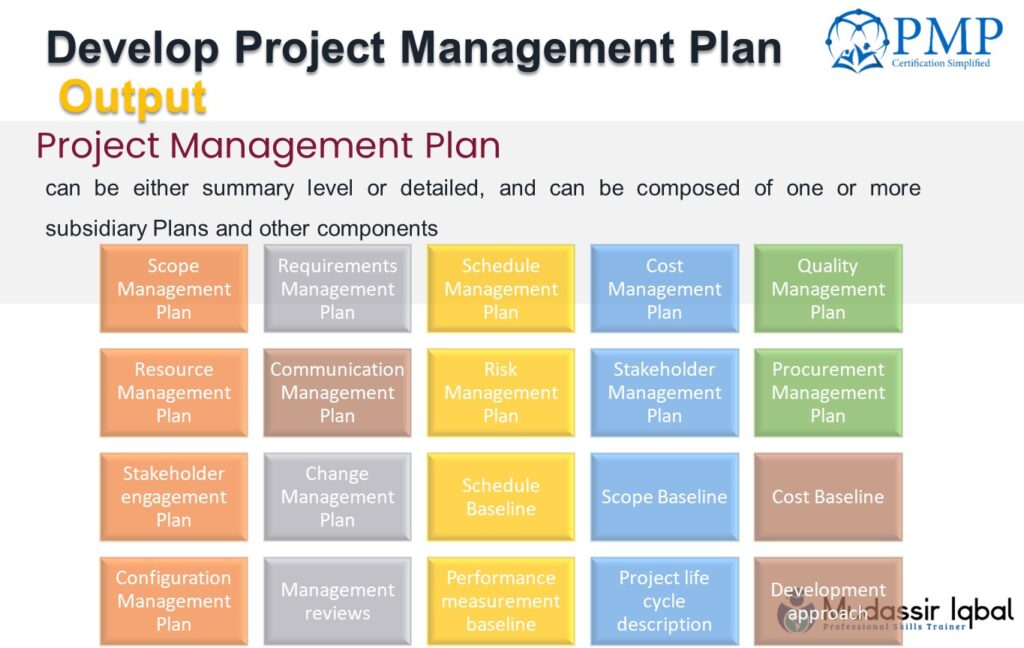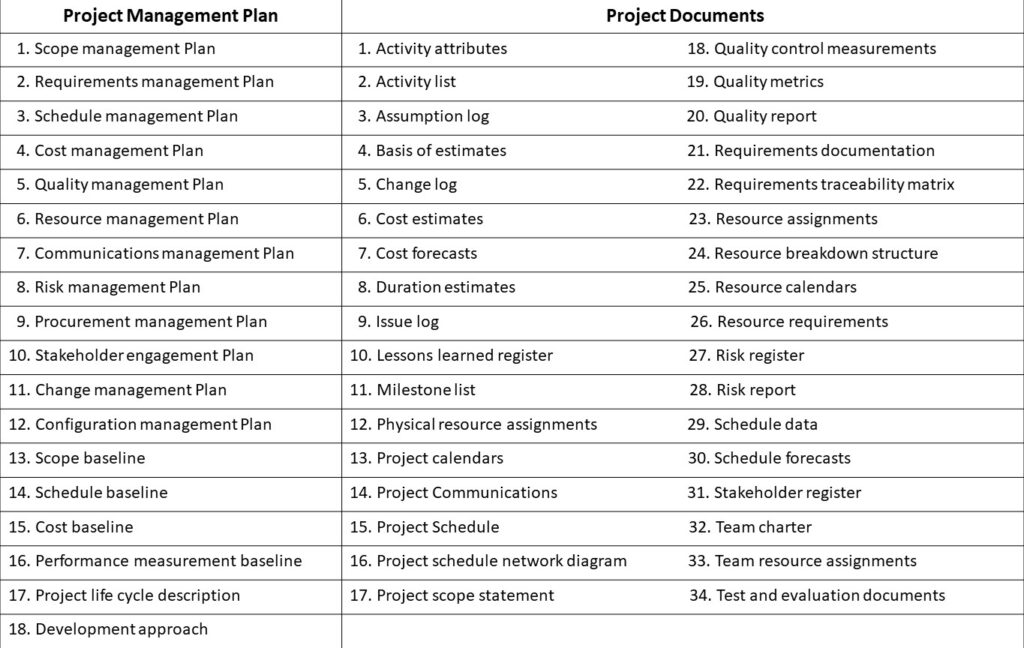A Project Management Plan (PMP) is a document that outlines how a project will be executed, monitored, and controlled. It includes information on the project’s objectives, stakeholders, deliverables, timelines, resources, and risks. The PMP serves as a guide for managing the project, and is typically developed by the project manager in collaboration with the project team and stakeholders. It is used to communicate the project’s goals, objectives, and approach to all project team members and stakeholders, and to ensure that the project stays on track and is completed within the defined scope, schedule, and budget.
Structure of Project Management Plan

The Project Management Plan is the key document that contains the overall Planning, monitoring, and implementing activities to be done on a project. We should plan before we act. The project management Plan is the foundation and guideline for all project work and works as a communication beacon for the project

Project Management Plan Documents
A Project Management Plan (PMP) typically includes several subsidiary plans that provide more detailed information on specific aspects of the project. These subsidiary plans can include:
- Scope Management Plan:
A subsidiary plan that outlines how the project’s scope will be defined, managed and controlled, including the process of planning, execution, monitoring and controlling the scope of the project. It helps to ensure that the project stays within defined boundaries, completed within schedule and budget. - A Requirements Management Plan (RMP):
A subsidiary plan that defines how the project’s requirements will be identified, analyzed, documented, tracked and managed throughout the project. It is used to ensure that the project’s objectives and deliverables are clearly defined and that the final product meets the needs of the stakeholders. - Schedule Management Plan:
A subsidiary plan outlines how the project schedule will be developed, monitored and controlled. It includes milestones, deadlines, and dependencies and is used to track project progress and make adjustments as needed. It helps to ensure that the project is completed on time and the objectives are met. - Cost Management Plan:
CMP outlines how the project budget will be developed, monitored and controlled. It describes how costs will be controlled and tracked throughout the project and helps to ensure that the project is completed within budget and the objectives are met. - Quality Management Plan:
Outlines how the project’s quality will be defined, managed and controlled. It defines the quality standards that will be used to evaluate the project’s deliverables and how quality will be monitored and controlled throughout the project. The goal is to ensure that the final product meets the needs and expectations of the stakeholders. It helps to ensure that the project deliverables are of high quality, reliable and meet the requirements of the stakeholders. - Resource Management Plan:
Outlines how the project’s resources (e.g. personnel, equipment, materials) will be acquired, allocated and managed. It helps to ensure that the project is completed with the necessary resources, within budget and schedule. It also includes identifying and tracking the availability of resources and managing any conflicts that may arise. - Communication Management Plan:
Outlines how project information will be shared with stakeholders and how stakeholders will be kept informed of project progress. It helps to ensure that all project members and stakeholders are well-informed, and that any issues or problems are promptly addressed and resolved. - Risk Management Plan:
Outlines the potential risks to the project and the strategies that will be used to mitigate or manage those risks. It involves identifying, analyzing, and prioritizing risks and then developing a plan to manage those risks effectively. It helps to ensure that the project is completed successfully by identifying and mitigating potential risks, and it also enables the team to take advantage of opportunities that may arise. - Procurement Management Plan:
Outlines how goods and services will be procured and how contracts will be managed throughout the project. It includes the processes and procedures for identifying, selecting, and managing suppliers and vendors, and for handling any issues or disputes that may arise. It helps to ensure that the project is completed with the necessary resources within budget and schedule and that all procurement activities are done in accordance with the organization’s policies and procedures. - Change Management Plan
outlines how changes to the project will be managed and controlled. It includes the process for identifying, evaluating, and approving changes to the project scope, schedule, and budget. It helps to ensure that any changes to the project are properly evaluated and that they align with the project goals and objectives and that the project stays on track. - Baselines
The Scope, Cost, and Schedule Baselines are three important components of a Project Management Plan. The Scope Baseline defines the project’s objectives, deliverables and requirements. The Cost Baseline outlines the project budget and the approved funds allocated for the project. The Schedule Baseline provides the project schedule, including milestones and deadlines. These baselines serve as a point of reference for the project team to measure progress, identify and manage variances, and make adjustments as needed. They also help to ensure that the project stays on track and is completed within the defined scope, schedule, and budget. - Performance Measurement Baselines (PMB)
are standards or targets that are established during the planning phase of a project, against which the project’s actual performance will be measured. PMB’s are used to track and measure the progress of a project and to evaluate its performance. The PMB’s can include metrics such as cost, schedule, scope, quality, and resource utilization. By comparing the actual performance of the project to the PMB’s, project managers can identify variances, take corrective actions and adjust the project plan as needed to meet the project objectives. - Project Life Cycle Approach
A project life cycle is a series of phases that a project goes through from its initiation to its closure. The typical project life cycle includes the following phases: initiation, planning, execution, monitoring and controlling, and closure. During the initiation phase, the project’s goals and objectives are defined, and a project team is assembled. The planning phase includes developing a project plan and identifying the resources required. In the execution phase, the project plan is put into action. The monitoring and controlling phase includes tracking progress and making adjustments as needed. The closure phase includes finalizing all project activities and documenting the results. - A Development Approach
refers to the method or process used to develop and implement a project. There are several different development approaches, including Waterfall, Agile, Scrum, Lean, and DevOps. Each approach has its own unique set of characteristics, and the choice of approach will depend on the specific requirements of the project and the organization. The waterfall is a linear sequential approach, Agile emphasizes on flexibility and adaptability, Scrum is an Agile framework for managing projects, Lean focuses on maximizing efficiency and minimizing waste, and DevOps is a culture and approach that emphasizes collaboration and communication between development and operations teams.
All these plans work together to ensure that the project is executed successfully and completed within the defined scope, schedule, and budget.
Download the Template of the Project Management Plan
Benefits of Project Management Plan
A Project Management Plan (PMP) is an essential document for managing a project effectively. It outlines how a project will be executed, monitored, and controlled. The PMP serves as a guide for managing the project, and is typically developed by the project manager in collaboration with the project team and stakeholders. The benefits of having a PMP include:
- Clarifying project objectives and deliverables: A PMP helps to ensure that the project’s goals and objectives are clearly defined and understood by all project team members and stakeholders.
- Improving communication: A PMP helps to ensure that project information is shared effectively with stakeholders and that stakeholders are kept informed of project progress.
- Improving efficiency: A PMP helps to ensure that the project is completed within the defined scope, schedule, and budget as per the agreed quality
- Managing change: A PMP includes a Change Management Plan that outlines how changes to the project will be managed and controlled.
- Use the PMP as a guide: The PMP should be used as a guide for managing the project. Project team members should refer to the PMP for information on the project’s objectives, deliverables, timelines, resources, and risks.
- Monitor and control the project: The project manager should use the PMP to monitor the project’s progress and make adjustments as needed. This includes monitoring the project’s schedule and budget, as well as controlling the project’s scope and quality.
Overall, a PMP serves as a roadmap for the project, helping to ensure that it stays on track and is completed successfully.


One thought to “Project Management Plan and Subsidiary plans : PMP/CAPM”
Pingback: Project Integration Management - PMP/CAPM by Mudassir Iqbal, PMP